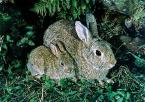|
Did You Know Wild Rabbits are Herbivores?
Even though domesticated and wild rabbits are cousins, there are big differences. For one, rabbits in the wild will know how to lookout for themselves whereas his cousin will not.
In the wild, rabbits are definitely prey animals. That is why they have powerful hind legs, to help them escape. Wild rabbits can reach speeds up to 24 miles per hour. They also use their front legs to burrow underground to hide.
They live in underground burrows called a Warren. There are usually 8 to 15 rabbits living together in a community. Being a cautious animal, they don’t travel too far from their burrows. So if you see rabbits eating in your yard or a field, you know their home is nearby.
They usually leave their home at dawn and dusk to eat. No matter what the weather is, they will come out to eat. They eat the wild grass and plants. Rabbits are an herbivore, meaning they only eat plants.
It is true that rabbits do multiply quickly. A healthy female has an average of three litters a year and each litter has four to five babies. The gestation period is only four weeks and rabbits reach their sexual maturity at six months.
During the gestation period the female rabbit will make her own burrow near the others. This is because the male rabbits may become aggressive toward the baby rabbits and kill them.
When the babies are three weeks old they are weaned from their mothers and can fend for themselves. So if you find a wild baby rabbit in your yard that doesn’t mean they are abandoned. The mother bunny is out eating or making sure other animals stay away from her babies.
Here are some tips to remember if you come across wild baby rabbits.
If their eyes are open, they have fur and are hopping around, then they are probably fine and should be left alone. Remember, at three weeks they are weaned from their mothers.
Find a nest of newborns? Also, leave them alone. The mother bunny is nearby. They only nurse their young five minutes a day since the mother’s milk is very rich.
But you can check on the newborns for the next 24 to 48 hours to make sure they are not abandon. Just make sure you do not scare the mother rabbit away. You can tell if the newborns are abandoned if they are constantly crying and their little bellies are sunken-in. If you find abandoned newborns, contact a wildlife rehabilitator in your area. You can call your vet or local animal shelter for the information. Please note that hand-raising wild rabbits can be difficult.
Also Know – Rabbits will not reject their young if you touch them.
Remember, a mother rabbit will only nurse their babies a few minutes at night
Wild baby rabbits do not have a scent. They will not attract other animals to harm them by a scent only by sight or sound.
The mother rabbit will be away from her babies most of the time. She’ll be eating and trying to distract predators away from her babies.
Never give a rabbit cow’s milk. If needed, give the baby rabbits kitten replace milk,KMR, from your pet store or goat’s milk. Do not over feed the baby. If the baby is old enough, water and timothy or alfalfa hay is best. No carrots or fruits.
If you find a domesticated rabbit outside, they are not a wild rabbit. They are a Feral rabbit. They are a domesticated rabbit that was once someone’s pet and the owner released it in the wild to fend for itself.
If you come across a Feral rabbit, you can take it to your local rabbit adoption agency or local animal shelter. These little creatures were someone’s pets and they do not know how to live in the wild. They do not know how to fend for themselves.
They are dependent on humans to feed them and take care of them and now someone has let them loose outdoors to live in the wild. Most times feral rabbits die because they do not know what plants to eat, or where to get water. They don’t know how to burrow themselves underground to get away from harm. And feral rabbits and wild rabbits cannot mate nor produce young together.
|







